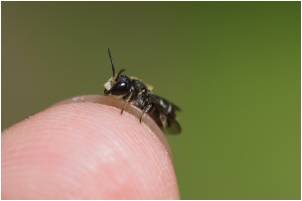Why do bees need flowers and plants?
Bees need flowers and plants primarily for food. In particular, they gather nectar and pollen from the flowers with which to provide the nutrients they need to feed themselves and their young.
However, it may surprise people to learn that depending on the species of bee, flowers and plants (including trees) may have other uses for bees too! These uses typically include:
- a site for a nest
- materials for a nest
- materials to disguise a nest
- a resting place.
10 ways different species of bees may use flowers, plants and trees
Aside from the nectar and pollen, leaves, petals, plant hairs, plant stems, oils and resins may also be gathered. Nests may be created in hollow stems, holes and crevices in tree trunks.
1. Nectar from flowers
Nectar contains sugar (carbohydrate) which provides bees with lots of energy. You can read more about this topic on my page: 'Why do bees need nectar and pollen?'.
 Bumble bee gathering pollen from the anthers of a rose flower.
Bumble bee gathering pollen from the anthers of a rose flower.2. Pollen from flowers
Pollen contains essential protein and fats and provides essential food for developing larvae.
3. Leaves
Some species use segments of leaf or petal for creating nest cells - leafcutter bees are well known for this activity. In the very short video below, you can watch a leafcutter bee returning to its nest cell with a segment of leaf.
4. Petals
Likewise, other bees such as the silvery leaf cutter, and the poppy mason bee use pieces of petal to line their nest cells, among other species.
5. Plant hairs
It's not only the flowers that are of interest to bees. Some species are also interested in the plant hairs found on some leaves and stems. For example, wool carder bees collect hairs for their nests from leaves and stems of plants - typically Lamb's ear - Stachys byzantina.
 Wool carder bees gather hairs from plants such as Lamb's ear.
Wool carder bees gather hairs from plants such as Lamb's ear.
6. Floral oils
For some species of bee, floral oils are very important, in particular to Macropis - or oil-collecting bees. These bees have extra long, specially adapted hairs on their hind legs which they use to gather the floral oils. The floral oils are used to line and waterproof their nest, and are mixed with flower pollen to feed their young.
Not just any floral oils will do, however. These bees forage on loosestrife flowers which somewhat results in this species being restricted to locations where the flower can be found. In the USA there are four known Macropis species, in the UK just one.
7. Resins
 Heriades truncorum - large headed resin bee.
Heriades truncorum - large headed resin bee.Some bees occupy old insect holes, such as small beetle burrows in wood, and gather resins with which to line their nest cells. An example is Heriades truncorum - the large headed resin bee - as you can see, a very tiny bee - pictured above.
8. Plant stems
It is also well known that some bees shelter or create their nests in hollow plant stems. For this reason, I advise against cutting and burning dry plant stems. Instead, put them in a pile at the back of the garden out of view. Hollow stems can be used to create insect houses, which may attract bees, such as red mason bees.

The red-tailed mason finds thin stems of dried grass close to a nest she creates in an empty snail shell, and creates a thatch over the shell, presumably to conceal her nest. Watch the red-tailed mason bee - Osmia bicolor.
9. Tree trunk holes and crevices
Some bee species happily create nests in the crevices and holes of trees. Below is are images indicating the location of a wild honey bee nest in a tree trunk.
 Honey bees around the entrance of the nest
Honey bees around the entrance of the nest Location of the nest in the tree
Location of the nest in the tree
10. A place to rest
It's not uncommon to see bees resting, or even apparently snoozing inside or on a flower - particularly where bumble bees are concerned. This was the case with the Bombus barbutellus male below.
 It's not uncommon to see a bumble bee apparently resting or snoozing on a flower - like this Bombus barbutellus male.
It's not uncommon to see a bumble bee apparently resting or snoozing on a flower - like this Bombus barbutellus male.More articles about bees and plants
- Bees And Brambles: The Value Of Brambles To Bees Also known as blackberry bush, research shows each bramble flower secretes lots of nectar for bees!
- Bees And Bee Balm Bee Balm (Monarda) - also known as 'Bergamot) is a herbaceous perennial which is attractive for bees.
- 30 Fantastic Garden Flowers For Bees Flowering plant recommendations for the perfect bee garden.
- Bees love lupins – but so do slugs and snails, so what can you do? Here's a way to protect your lupins....using garlic!
- Plant Oregano For Bees (Marjoram) It's rich in nectar, and attracts bees, butterflies and hoverflies in summer. Here's how to plant it.
- Fennel Pollen And Nectar Bees love fennel! How to grow it, gather it, and the many uses of fennel seeds and pollen.


